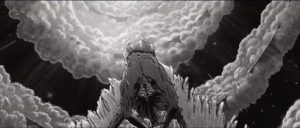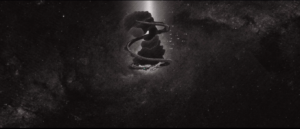“Rattle That Lock” is the title track of David Gilmour’s 2015 stand-alone album, and the video for the Miltonic-themed song, carried out by the company Trunk Animation, brings to life Gustave Doré’s spectacular engravings for Milton’s Paradise Lost.
Polly Samson, wife of Gilmour and lyricist behind “Rattle That Lock,” explained that the inspiration for the song was “the need not to fall into an apathetic or despairing state” in the face of the seemingly unshakeable status quo, which makes would-be protestors feel increasingly hopeless, Samson asserting, “even if you can’t change anything, personally you’ll feel better if you go and kind of shake your fist…rather than just sort of slump.” Samson found the most dramatic expression of this sentiment in Milton’s Paradise Lost—both in the heroic journey the Hell-doomed rebel angel Satan takes through Chaos to reach Eden—in defiance of the God who expelled him from Heaven—and in the exile of Adam and Eve, who take “thir solitary way” (XII.649) out of Eden’s eastern gate. The lyrics for the song unmistakably allude to Milton—with a Satanic Romantic slant on the Miltonic treatment of the Fall:
Whatever it takes to break
Gotta do it
From the burning lake or the eastern gate
You’ll get through it
Rattle that lock, lose those chains…
Gilmour applauded the brilliant video for “Rattle That Lock,” which he found “highlights a darkness in the song that couldn’t have been shown any other way.” Samson commended the creators of the video for capturing that darkness by invoking the spirit of Doré’s vision of Paradise Lost: “I think the animators have done a fine job: paying homage to Gustave Doré…” Appropriately dubbed “the last of the Romantics,” the nineteenth-century French engraver Doré was almost superhumanly prolific, creating scores of incredible wood engravings for the Bible, Dante’s Divine Comedy, and of course Milton’s Paradise Lost. Doré’s fifty engravings for Paradise Lost were commissioned in 1866, and these genuinely marvelous pieces are the most popular illustrations of Milton’s masterpiece. If the layperson has seen Milton’s Satan, it has most likely been Doré’s interpretation of the ruined archangel, and it would be impossible for anyone who has laid eyes on Doré’s depiction of Paradise Lost and its Satan to miss their reappearance in the video for “Rattle That Lock.”
The very first moments of the “Rattle That Lock” video capture the spirit of Doré’s masterful work: serenity, interrupted by catastrophe, which appears somehow magnificent. Opening with celestial light shining through thick clouds in tune with the jingle repeated throughout the song—the jingle that precedes French railway station announcements, actually—robed shades ascend by way of a vast circular staircase, the peace suddenly broken by the lone figure of Lucifer, who plummets rapidly from the light up above. This Lucifer’s look is distinctly Doréan: beautiful and barefoot, but donning a Roman tunic and regal body armor. The shackled angel falls haplessly down through the middle of the spiraling heavenly staircase, his feathery wings molting as he falls. With perhaps a nod to the legend of the emerald crown of the fallen Lucifer residing somewhere in the world (the subject of Swedish metal band Therion’s “Emerald Crown,” incidentally), this Lucifer witnesses the emerald at the center of his armor released into the air. Before long, the armor itself is stripped off, and as the falling angel approaches the fiery lake below, we see true terror in his emerald-green eyes—the only color in the otherwise black-and-white video, made to resemble Doré’s engravings. His final feather plucked by the unforgiving winds, Lucifer is left with scabbed bat-wings, and, having failed to wriggle his wrists out of their shackles, he protects himself from the impending impact by encasing himself within his now leathery pennons, plunging into the lake below.
Even though this Lucifer falls from Heaven alone rather than with his legions of rebel angels, his fall captures the spirit of Milton’s dramatic description of Satan “Hurl’d headlong flaming from th’ Ethereal Sky” (I.45) at the start of Paradise Lost. After the fall, the video becomes much more abstract, but a number of Miltonic moments are still discernible. The fallen angel emerges from his wings as if from a shell, having assumed the form of a cormorant. In Paradise Lost, Satan assumes various animal disguises during his covert mission in Eden, first observing Adam and Eve as a cormorant, seated atop the Tree of Life (IV.194 ff.). In the “Rattle That Lock” video, as the Satanic cormorant makes his way through the waters and reaches the surface, we bear witness to the dreary Underworld, which is much more Dantean than Miltonic. While Paradise Lost catalogues mortal misfortune in its account of the Paradise of Fools (III.440–97), Milton curiously makes no mention of the tormented damned, and in fact his fallen angels engage in Olympian Games, mining, music, philosophy, and exploration in Hell (II.528–628). Doré followed Milton’s lead in his engravings for Paradise Lost, illustrating the native denizens of Hell—“worse / Than Fables yet have feign’d, or fear conceiv’d, / Gorgons and Hydras, and Chimeras dire” (II.626–28)—and the Paradise of Fools, but not human torment in Hell. The animators for “Rattle That Lock” opted for Doré’s gruesome depictions of Dante’s Hell.
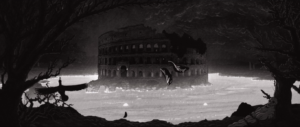 In the midst of his flight, the Satanic cormorant snatches prey from the air and enters into Pandaemonium—here imagined as the Colosseum—which, unlike Paradise Lost’s “high Capitol / Of Satan and his Peers” (I.756–57), is desolate. The cormorant lands atop Hell’s throne, which actually resembles the throne John Martin imagined for Milton’s Satan, and feeds his prey to the newly hatched serpents seated on the throne, which I assume represent the “Discord, Chance and Rumor” mentioned in the lyrics—a reference to three of the various forces at work in the realm of Chaos in Paradise Lost (II.965–67). The proud Satanic cormorant then takes flight once again, heading toward the gates of Hell, soaring past the vast wasteland of classical ruins beneath him, his falling feathers bringing bad influence, such as the Dantean wood of the suicides.
In the midst of his flight, the Satanic cormorant snatches prey from the air and enters into Pandaemonium—here imagined as the Colosseum—which, unlike Paradise Lost’s “high Capitol / Of Satan and his Peers” (I.756–57), is desolate. The cormorant lands atop Hell’s throne, which actually resembles the throne John Martin imagined for Milton’s Satan, and feeds his prey to the newly hatched serpents seated on the throne, which I assume represent the “Discord, Chance and Rumor” mentioned in the lyrics—a reference to three of the various forces at work in the realm of Chaos in Paradise Lost (II.965–67). The proud Satanic cormorant then takes flight once again, heading toward the gates of Hell, soaring past the vast wasteland of classical ruins beneath him, his falling feathers bringing bad influence, such as the Dantean wood of the suicides.
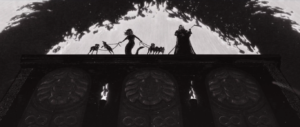 Atop the towering gates of Hell are Sin and Death, who differ from their Miltonic (and Doréan) incarnations. In Paradise Lost, Sin—who burst unbidden out of the celestial conspirator Satan’s haughty head (II.749–58), a la Athena from the head of Zeus—is described as a fair woman from above the waist and a monstrous serpent from the waist down, reflecting her father’s transformation from glorious Lucifer to darkened Satan. Sin became so deformed, she explains to her fallen father, because of their incestuous union. “Likest to thee in shape and count’nance bright, / Then shining heav’nly fair” (II.756–57), Sin tells Satan, the prideful angel saw in his daughter his own “perfect image” (II.764), and in turn “Becam’st enamor’d” (II.765), Satan’s sinful self-love made literal. The fruit of their incestuous intercourse is Death, Satan’s “Son and Grandchild both” (X.384), who rapes his mother, marring the lower half of her perfect form into a monstrosity (II.761–802), not least of which are the barking Hell-hounds, which retreat into Sin’s nether region only to gnaw at her bowels. (In the “Rattle That Lock” video, Sin holds the unruly dogs by leash.) In their explosive first encounter, Death boasts that he is Satan’s “King and Lord” (II.699), only prevented from killing his indignantly incensed (grand)father by his mother, Sin (II.704–26). Playing on the biblical passage observing that “when lust hath conceived, it bringeth forth sin: and sin, when it is finished, bringeth forth death” (James 1:15), Milton’s infernal parody of the Trinity with Satan, Sin and Death is meant to demonstrate—in horrid vividness—the self-destruction resulting from Satanic self-aggrandizement. While the “Rattle That Lock” video appears to connote a similar idea with the Satanic cormorant’s feeding of the three serpents, which are hostile to one another, there is none of the infernal family feuding here; indeed, Death—who resembles more the stereotypical grim reaper than Milton’s challenging description of a nebulous “shadow” donning on “what seem’d his head / The likeness of a Kingly Crown” (II.669, 672–73), which was a copout several Milton illustrators resorted to—in this case welcomes Satan, Death inviting him to enter through the Hell-gates.
Atop the towering gates of Hell are Sin and Death, who differ from their Miltonic (and Doréan) incarnations. In Paradise Lost, Sin—who burst unbidden out of the celestial conspirator Satan’s haughty head (II.749–58), a la Athena from the head of Zeus—is described as a fair woman from above the waist and a monstrous serpent from the waist down, reflecting her father’s transformation from glorious Lucifer to darkened Satan. Sin became so deformed, she explains to her fallen father, because of their incestuous union. “Likest to thee in shape and count’nance bright, / Then shining heav’nly fair” (II.756–57), Sin tells Satan, the prideful angel saw in his daughter his own “perfect image” (II.764), and in turn “Becam’st enamor’d” (II.765), Satan’s sinful self-love made literal. The fruit of their incestuous intercourse is Death, Satan’s “Son and Grandchild both” (X.384), who rapes his mother, marring the lower half of her perfect form into a monstrosity (II.761–802), not least of which are the barking Hell-hounds, which retreat into Sin’s nether region only to gnaw at her bowels. (In the “Rattle That Lock” video, Sin holds the unruly dogs by leash.) In their explosive first encounter, Death boasts that he is Satan’s “King and Lord” (II.699), only prevented from killing his indignantly incensed (grand)father by his mother, Sin (II.704–26). Playing on the biblical passage observing that “when lust hath conceived, it bringeth forth sin: and sin, when it is finished, bringeth forth death” (James 1:15), Milton’s infernal parody of the Trinity with Satan, Sin and Death is meant to demonstrate—in horrid vividness—the self-destruction resulting from Satanic self-aggrandizement. While the “Rattle That Lock” video appears to connote a similar idea with the Satanic cormorant’s feeding of the three serpents, which are hostile to one another, there is none of the infernal family feuding here; indeed, Death—who resembles more the stereotypical grim reaper than Milton’s challenging description of a nebulous “shadow” donning on “what seem’d his head / The likeness of a Kingly Crown” (II.669, 672–73), which was a copout several Milton illustrators resorted to—in this case welcomes Satan, Death inviting him to enter through the Hell-gates.
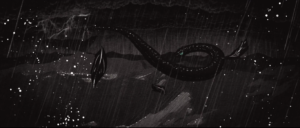 The Satanic cormorant enters through the three layers of the gates of Hell—brass, iron, and adamant in Paradise Lost (II.643–48)—and enters into Chaos. The realm of Chaos proved another difficult Miltonic description, confounding artists who attempted to portray it. Doré’s engraving for Satan venturing through Chaos portrays the fallen angel straddling a mountainous cliff, but in the “Rattle That Lock” video Chaos is portrayed as more of a tempestuous, oceanic space—and, as such, is somewhat closer to Milton’s description (II.890–927). In the video, upon entering Chaos, Satan assumes his final, serpentine form, slithering through the air in defiance of the fierce winds, waves, lightning, and flaming rainfall. Finally, the Satanic serpent pierces through to our cosmos, our vulnerable world reflected in his glassy eye. Darting downward, the Satanic serpent descends toward the Earth in spirals. What follows next: “all Hell broke loose,” in the words of Milton (IV.918), a massive vacuum sucking the Underworld through the gates of Hell and Chaos, the debris (including the chain which bound the fallen angel earlier) swirling downward with the serpent, encircling the Earth. As Nature is disrupted by earthquakes and volcanic eruptions, the “golden Chain” suspending our “pendant world” (II.1051–52) is withdrawn into the ocean as the serpent and the sulfurous swirls which follow in his wake enwrap the globe, the camera zooming out to reveal the planet free-floating, seemingly alone in the universe, alienated from Heaven.
The Satanic cormorant enters through the three layers of the gates of Hell—brass, iron, and adamant in Paradise Lost (II.643–48)—and enters into Chaos. The realm of Chaos proved another difficult Miltonic description, confounding artists who attempted to portray it. Doré’s engraving for Satan venturing through Chaos portrays the fallen angel straddling a mountainous cliff, but in the “Rattle That Lock” video Chaos is portrayed as more of a tempestuous, oceanic space—and, as such, is somewhat closer to Milton’s description (II.890–927). In the video, upon entering Chaos, Satan assumes his final, serpentine form, slithering through the air in defiance of the fierce winds, waves, lightning, and flaming rainfall. Finally, the Satanic serpent pierces through to our cosmos, our vulnerable world reflected in his glassy eye. Darting downward, the Satanic serpent descends toward the Earth in spirals. What follows next: “all Hell broke loose,” in the words of Milton (IV.918), a massive vacuum sucking the Underworld through the gates of Hell and Chaos, the debris (including the chain which bound the fallen angel earlier) swirling downward with the serpent, encircling the Earth. As Nature is disrupted by earthquakes and volcanic eruptions, the “golden Chain” suspending our “pendant world” (II.1051–52) is withdrawn into the ocean as the serpent and the sulfurous swirls which follow in his wake enwrap the globe, the camera zooming out to reveal the planet free-floating, seemingly alone in the universe, alienated from Heaven.
As the “Rattle That Lock” video ends, we are left with the same ambivalent impression made by Milton’s poem: while we sympathize with the fallen angel who is cast down from Heaven into Hell, and while we admire Satan for his dauntless courage—exhibited not least in his temerity as a voyager—we are made to remember the end result of Satan’s heroic voyage: the infernal conquest of the world. All the same, the dramatic fall of Lucifer at the start of the video is genuinely Romantic: catastrophic loss and liberation intertwined. “Rattle that lock, lose those chains,” the chorus chants as Lucifer plummets toward the lake of fire, the voice of Gilmour reassuring us that “From the burning lake or the eastern gate / You’ll get through it…” The message matches that of the Romantic Satanists: “Whatever it takes to break / Gotta do it…”
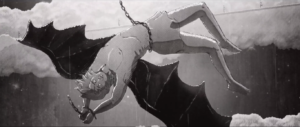 Whether it’s the fallen archangel chained on Hell’s burning lake or our postlapsarian parents exiled through Eden’s eastern gate, what matters most is that, even if they could not break their fetters, they rattled their locks. Milton’s Satan could not overthrow Almighty God, but by his doomed defiance, Satan “shook his throne” (I.105) inasmuch as he refused to offer “Knee-tribute…prostration vile” (V.782), and even in Hell disdained “To bow and sue for grace / With suppliant knee, and deify his power,” which, the prideful Satan declares, “were an ignominy and shame beneath / This downfall…” (I.111–16). “Satan wants to go on being Satan,” observed Christian apologist and Milton critic C. S. Lewis. “That is the real meaning of his choice ‘Better to reign in Hell, than serve in Heav’n’ [I.263].”1 We can all sympathize with the spirit of this: we face seemingly insurmountable forces in life, but trudge on, wading through the world in a struggle to stay true to ourselves. It a sentiment at the heart of Romantic Satanism, captured quite beautifully in Gilmour’s “Rattle That Lock” song and its accompanying video, which, if nothing else, is the closest we’ve come to getting an animated film of Paradise Lost, demonstrating the potential in such an endeavor.
Whether it’s the fallen archangel chained on Hell’s burning lake or our postlapsarian parents exiled through Eden’s eastern gate, what matters most is that, even if they could not break their fetters, they rattled their locks. Milton’s Satan could not overthrow Almighty God, but by his doomed defiance, Satan “shook his throne” (I.105) inasmuch as he refused to offer “Knee-tribute…prostration vile” (V.782), and even in Hell disdained “To bow and sue for grace / With suppliant knee, and deify his power,” which, the prideful Satan declares, “were an ignominy and shame beneath / This downfall…” (I.111–16). “Satan wants to go on being Satan,” observed Christian apologist and Milton critic C. S. Lewis. “That is the real meaning of his choice ‘Better to reign in Hell, than serve in Heav’n’ [I.263].”1 We can all sympathize with the spirit of this: we face seemingly insurmountable forces in life, but trudge on, wading through the world in a struggle to stay true to ourselves. It a sentiment at the heart of Romantic Satanism, captured quite beautifully in Gilmour’s “Rattle That Lock” song and its accompanying video, which, if nothing else, is the closest we’ve come to getting an animated film of Paradise Lost, demonstrating the potential in such an endeavor.
Notes
1. C. S. Lewis, A Preface to Paradise Lost (London: Oxford University Press, [1942] 1961), p. 103.↩
